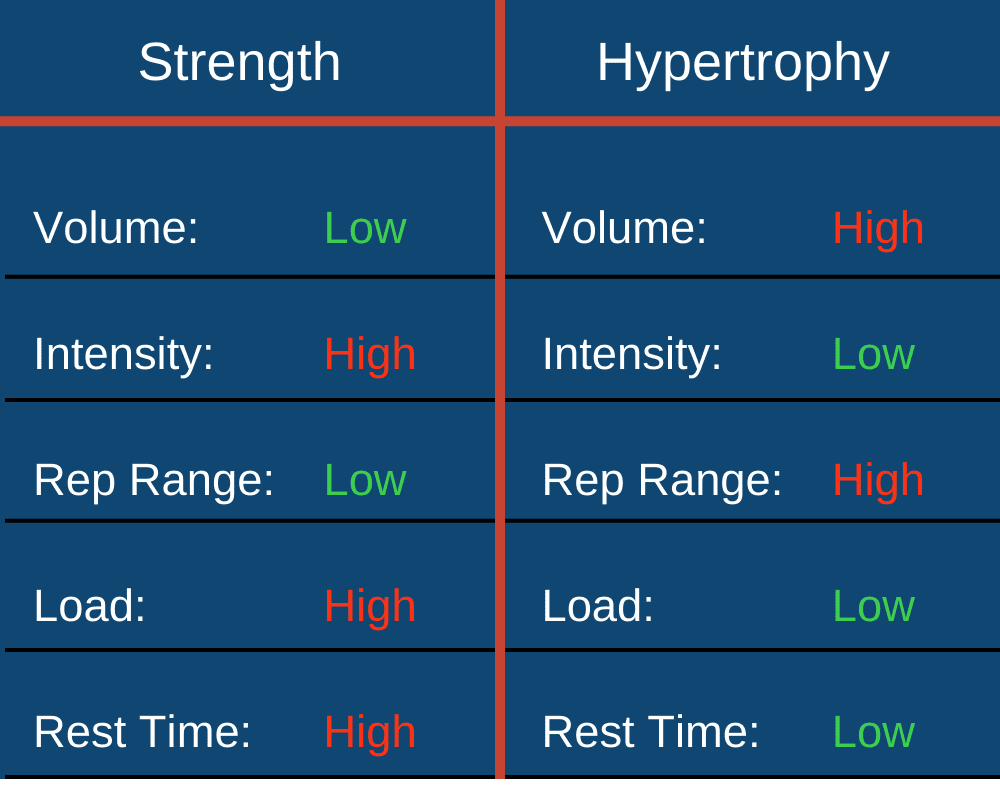Hypertrophy Training & Strength Training Differences – The Ultimate Guide
In the world of resistance training, there are two main methods that people use to reach their goals in the gym. Strength training and hypertrophy training require two different techniques and accomplish two completely different goals. The most important difference you will notice is the differences in volume and intensity. In this article, we will define each type of training, the different levels of volume and intensity required, and the benefits that each type offer. We will summarize the key differences between them, determine which type of training is right for your personal goals, and how to best incorporate each training type into your workout routine.
Hypertrophy Training & Strength Training Differences – The Ultimate Guide
What Is Strength Training?
Strength training is commonly defined as training done to increase the ability of a muscle to produce force. It is the primary objective of athletes such as powerlifters and a form of exercise that uses resistance or weights to increase muscle strength and endurance. For strength training, you will generally find yourself at the lower end of volume and the higher end of intensity. According to the American College of Sports Medicine, if you want to improve your strength, you want to use a high load of weight for a low repetition range of 1-5 reps. It is also advisable to take longer rest periods between sets using the same muscles, (3-5 minutes) as you will be using heavy weights, and your muscles will need to recover. A high load weight could be anything greater than or equal to 85% of your 1 repetition max. For example, if your 1 repetition max for a back squat is 200 Lbs, you should be using between 170 lbs and 200 lbs for 3 sets of 1-5 reps. settings.
Benefits Of Strength Training
The primary benefit of strength training is increased muscular strength. This can improve overall physical performance and reduce the risk of injury. With that out of the way, let’s get into some of the secondary benefits of strength training.
1. Improved body composition: Strength training can help reduce body fat and increase muscle mass
2. Improved bone density: Reduced risk of osteoporosis and bone fractures.
3. Improved insulin sensitivity: This can help regulate blood sugar levels and reduce the risk of type II diabetes.
4. Reduced risk of cardiovascular disease.
What Is Hypertrophy Training?
Hypertrophy is defined as the enlargement of a muscle due to an increase in the size of its individual cells. It is the primary focus of athletes such as bodybuilders. Instead of increasing muscle strength and endurance, hypertrophy training increases the physical size of a muscle. When doing this kind of training, you will find yourself at the higher end of volume and moderate intensity though you must still finish each set very close to failure to fatigue the muscle properly. The American College of Sports Medicine recommends 1-3 sets per exercise with a moderate repetition range of 8-12 reps and a load of 70%-85% of their 1 repetition maximum. It’s preferable to take shorter breaks between sets. You don’t want to give your muscles as much time to rest as the goal of hypertrophy training is to safely break down or damage the muscle as much as possible. For example, if your 1 repetition max for a back squat is 200 lbs, you ideally want to use between 140 lbs and 170 lbs to achieve hypertrophy.
Benefits Of Hypertrophy Training
The primary benefit of hypertrophy training is increased muscle size which can have a range of benefits for overall physical health and performance. The secondary benefits of hypertrophy training are as follows.
1. Increased muscle endurance: This allows for longer periods of physical activity before fatigue sets in.
2. Improved joint stability: This reduces the risk of injury during physical activity.
3. Increased muscle fiber recruitment: This leads to improved muscle activation and overall strength.
4. Improved muscle symmetry: This can improve overall physical appearance and reduce the risk of injury due to muscle imbalances.
Key Differences Between Strength And Hypertrophy Training
Each type of training is unique and not to be confused if you want to reach your fitness goals. We will now highlight the key differences between strength and hypertrophy training in a way that makes it easy for you to apply this information to your workout routine.
Goal
Strength: Strength training focuses on increasing the ability of a muscle to produce force or lift more weight.
Hypertrophy: Hypertrophy training focuses on increasing the physical size of a muscle.
Volume and Intensity
Strength: Strength training requires a low volume and high intensity.
Hypertrophy: Hypertrophy training requires a high volume and moderate intensity
Repetition Range
Strength: Strength training utilizes a low repetition range of 1-5 reps.
Hypertrophy: Hypertrophy training utilizes a moderate repetition range of 8-12 reps.
Load
Strength: Strength training requires a high load weight of 85% or greater of your 1 repetition max.
Hypertrophy: Hypertrophy training requires a moderate load of 70%-85% of your 1 repetition max.
Rest
Strength: Strength training requires longer rest periods between sets.
Hypertrophy: Hypertrophy training requires shorter rest periods.
By understanding the key differences between strength and hypertrophy training, you can choose the type of training that best suits your personal fitness goals and incorporate it into your workout routine accordingly.

How To Use This Information
Once you have decided what type of training you want to prioritize, just apply that training type’s recommended volume, intensity, repetition range, load, and rest between sets to your routine. It is also important to note that you don’t need to choose just one. They can also complement each other in a workout routine. It is possible to incorporate both types of training into a workout routine, alternating between days or focusing on different muscle groups during each session. With the right balance, you can achieve your fitness goals and improve your overall physical health and performance.
References:
- Effects of Low- vs. High-Load Resistance Training on Muscle Strength and Hypertrophy in Well-Trained Men
- American College of Sports Medicine position stand. Progression models in resistance training for healthy adults
- Low muscle mass and risk of type 2 diabetes in middle-aged and older adults: findings from the KoGES
- Strength training: Get stronger, leaner, healthier
- Build muscle mass while preventing joint damage
- Training According to Muscle Fiber Type
Charles Armstrong
Contributing Author
Charles Armstrong is a copywriter with a specialization in the fitness industry, and has a track record of success, having worked with Transfitnation over the course of several years. Additionally, he is an author and entrepreneur, using his skills to help others achieve their goals.
Start Your Transformation Today With A Free Evaluation Session
We Offer Online & Studio Personal Training Based In Smithtown, NY. New Client Special.
Related Articles:

5 Effective Ways To Burn Body Fat, Reduce Hunger & Lose Weight
Do you struggle to burn body fat and lose weight? By making small changes to your eating habits, you will see how easy it is to burn body fat, reduce hunger and...
2 Powerful Tools For Meal Planning: Meal Timing & Tracking
In this article, we aim to provide you with tips and tricks to help you “perfect” your diet/meal plan through meal timing and tracking.2 Powerful Tools For Meal...

How Staying Hydrated Can Help You Reach Your Fitness Goals
Hydration offers many well-known health benefits, such as regulating body temperature, lubricating joints, and protecting the spinal cord and sensitive tissues in...

9 Best Exercises Before Shoveling Snow
Use These 9 Essential Exercises Before Shoveling Snow To Reduce Back Pain & Prevent Injuries. Warm Up Your Body & Use The Right Lifting Techniques To Make Shoveling Snow Safe & Productive.

5 Full Body Exercises That Burn The Most Calories
Here Is A Workout With 5 Full-Body Exercises To Burn Body Fat, Build Muscle, And Burn The Most Calories!5 Full Body Exercises That Burn The Most Calories Dumbbell...

Stephan Reyes Named Person of the Year 2023
Stephan Reyes was honored as TBR News Media's Person of the Year for 2023. Stephan's commitment goes beyond early morning sessions. He strives for holistic...

Best Personal Trainers on Long Island 2024- Transfitnation
Transfitnation has been nominated for Best Personal Trainer on Long Island in the 2024 Best of LI awards. With past nominations in 2021 and 2022, we showcase our...

